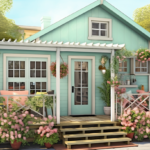Home and Garden
Creating a Green Haven: Enhancing Tiny Homes with Plants for Health and Happiness
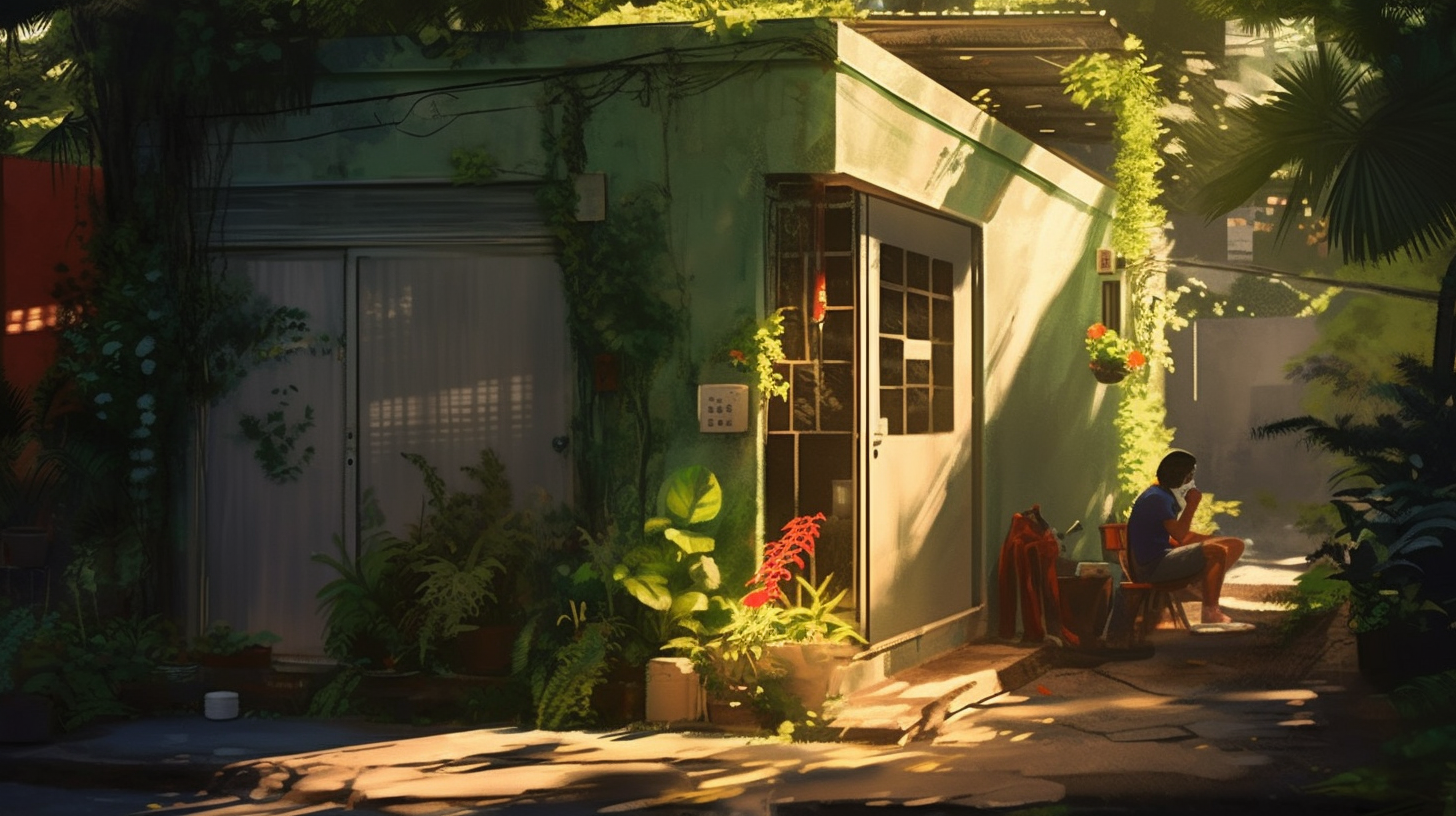
Nature In Your Tiny Home: Benefits Of Plants & How To Incorporate Them
Imagine living in a small home surrounded by lush greenery, breathing in the fresh, oxygen-filled air, and appreciating the beauty of nature. Despite seeming too small for plants, tiny homes can be transformed into green sanctuaries.
Incorporating plants in your tiny home can improve your living space and provide numerous benefits for your health and the environment. Living in a tiny home can be challenging, especially when it comes to space and air quality. However, plants can be a solution to these challenges.
They not only purify the air but also add a touch of natural beauty to your home. This article will explore the benefits of plants in tiny homes, ways to incorporate them, and low-maintenance plant options. We will also provide tips for creating a nature oasis in your tiny home, which can ultimately improve your overall well-being.
With the right knowledge and approach, you can make space for nature in your tiny home and experience the rewards it has to offer.
Key Takeaways
- Incorporating plants in tiny homes can improve air quality, add natural beauty, reduce stress, and promote relaxation and overall well-being.
- Maximize natural light, choose compact and efficient planters, utilize vertical space, and opt for low-maintenance plant options when incorporating plants in tiny homes.
- Low-maintenance plant options include succulents, spider plants, peace lilies, and Boston ferns.
- Plants can provide solutions for challenges faced in living in tiny homes such as improving air quality, adding aesthetic appeal, and providing benefits to overall health and well-being.
Improving Living Space
The incorporation of plants in tiny homes can improve living space by enhancing air quality, adding aesthetic appeal, and providing benefits to overall health and well-being.
Maximizing natural light is crucial when incorporating plants in tiny homes. Plants require sunlight to thrive, and it is essential to choose the right location for them within the home. Placing plants near windows is an excellent way to ensure they receive enough sunlight. Additionally, installing mirrors near plants can help reflect sunlight and maximize the amount they receive.
Choosing the right planters is also essential when incorporating plants in tiny homes. Due to limited space, it is crucial to choose planters that are compact and efficient. Hanging plants and wall-mounted planters are excellent options for those with limited floor space. Utilizing vertical space can also provide more room for plants while maximizing living space. Choosing planters that are easy to move and rearrange can also provide flexibility when needed.
By incorporating plants into tiny homes and maximizing natural light and choosing the right planters, living space can be improved significantly.
Incorporating Plants in Small Spaces
Surprisingly, even the tiniest of spaces can accommodate greenery with a bit of creativity and resourcefulness.
Vertical gardening is a popular technique for incorporating plants in small spaces. This method involves planting in upward direction, using walls, railings, and shelves as support.
DIY planters can be easily made from recycled materials such as tin cans, mason jars, and wooden boxes. These planters can be hung on walls or placed on high shelves to maximize space.
Additionally, porch space can be utilized for plants and flowers, adding natural beauty and fresh air to your tiny home. Incorporating plants in small spaces not only adds aesthetic appeal but also has numerous benefits.
Plants improve air quality and reduce toxins, making them ideal for tiny homes with limited ventilation. They also help reduce stress, promote relaxation, and improve overall well-being.
Vertical gardening and DIY planters are low-cost and low-maintenance ways to incorporate plants in tiny homes, making it possible for anyone to have their own nature oasis. With a little creativity and resourcefulness, even the smallest of spaces can be transformed into a green haven.
Low-Maintenance Plant Options
Low-maintenance plant options for small spaces can enhance vertical gardening and DIY planters. While plants are beneficial for overall health and well-being, not everyone has the time or energy to care for high-maintenance flora. Low-maintenance plants are the perfect solution for those who want to enjoy the benefits of greenery without the hassle.
When it comes to plant placement in tiny homes, low-maintenance options such as succulents, spider plants, peace lilies, and Boston ferns are ideal. Succulents are known for their ability to thrive in dry conditions and require minimal watering. Spider plants are easy to care for and help purify the air. Peace lilies are a great choice for low-light areas and can improve indoor air quality. Boston ferns are another low-maintenance option that adds a touch of elegance to any space.
Incorporating these low-maintenance plants can enhance the aesthetic appeal of a tiny home while also providing the benefits of greenery.
Frequently Asked Questions
What are some popular ways to DIY planters for tiny homes?
When it comes to DIY planter ideas for tiny homes, there are a variety of creative solutions available. One option is to repurpose old containers, such as jars, cans, or baskets, and turn them into unique planters.
Another idea is to use hanging planters, which can be made from macrame or repurposed materials like bottles or tea cups. Vertical gardens are also a popular choice for tiny homes, using shelving or pallets to create a living wall of plants.
When designing DIY planters for tiny homes, it’s important to consider the space available and the types of plants that will thrive in that environment. It’s also a good idea to incorporate sustainable materials and methods, such as using recycled materials or creating a self-watering system.
With a little creativity and planning, it’s easy to add greenery to a tiny home and create a nature oasis.
Can plants in tiny homes help with air purification?
Plants have been known to purify indoor air by removing harmful pollutants and releasing oxygen. This air purification benefit is one of the many advantages of incorporating plants into tiny homes.
Indoor gardening techniques such as using low-maintenance plant options like succulents, spider plants, peace lilies, and Boston ferns and optimizing vertical space by hanging plants on walls or placing them on high shelves can help to improve air quality.
However, it is important to note that plants still require sunlight and proper placement for minimal care. Therefore, research on plant size before choosing for decor is crucial.
In summary, incorporating plants in tiny homes can provide air purification benefits, but it is essential to use indoor gardening techniques to optimize their growth and maintenance.
What are some alternative options for those who do not have access to outdoor space for plants?
For those who do not have access to outdoor space for plants, indoor gardening and container gardening are great alternatives.
Indoor gardening refers to growing plants within your home, while container gardening refers to planting in containers such as pots, baskets, and raised beds.
With indoor gardening, you can utilize windowsills, shelves, and other vertical spaces to grow plants. Container gardening allows for flexibility in terms of placement and can be easily moved around for optimal sunlight exposure.
It is important to choose plants that are suitable for indoor and container gardening, such as herbs, small vegetables, and dwarf varieties of trees and shrubs. Proper care and maintenance, including watering, fertilizing, and pruning, are also crucial for the success of indoor and container gardening.
Are there any plants that are known to repel insects and pests in a tiny home setting?
Plants have been known to provide numerous benefits, including improving air quality and promoting relaxation, in addition to their aesthetic appeal. However, some plants can also serve as natural repellents for common pests like mosquitoes and flies. Natural repellents such as citronella, basil, and peppermint have been shown to be effective in keeping these pests away.
To prevent pest problems in a tiny home setting, it is important to choose the right plants and place them strategically. For example, placing citronella or basil near windows or doors can help keep insects from entering. While natural repellents can be effective, it is important to note that they may not completely eliminate pests and should be used in conjunction with other prevention tips such as keeping a clean living space and sealing any gaps or cracks where pests can enter.
How can plants in tiny homes contribute to mental health and wellbeing?
The benefits of greenery on mental health and well-being have been well documented in scientific studies. Exposure to natural environments has been associated with improved mood, reduced stress, and increased cognitive function.
Plants can contribute to these positive effects by providing a natural and calming atmosphere within a tiny home. In addition, proper placement of plants can allow natural light to enter the living space, which has also been shown to have positive effects on mental health and well-being.
Therefore, incorporating plants into a tiny home can have significant benefits on mental health and overall well-being.
Conclusion
Living in a tiny home can be challenging, but incorporating plants can improve your living space and overall health. Plants provide numerous benefits, such as purifying the air, reducing stress, and providing home-grown food.
This article explored the benefits of plants in tiny homes, ways to incorporate them, and low-maintenance plant options. Incorporating plants in small spaces can be challenging, but there are many creative ways to do so. Vertical gardens, hanging baskets, and window boxes are just a few examples. Low-maintenance plant options, such as succulents and air plants, are also great choices for tiny homes. With proper care, these plants can thrive in small spaces and provide numerous benefits.
In conclusion, incorporating plants in your tiny home is a great way to make space for nature and reap the rewards. Plants can enhance your overall well-being by improving your living space, reducing stress, and providing home-grown food. With the right knowledge and approach, you can create a nature oasis in your tiny home and enjoy the beauty and benefits of nature.
So, go ahead and add some greenery to your tiny home and start reaping the rewards today!
Hi, I’m Emma. I’m the Editor in Chief of Tiny House 43, a blog all about tiny houses. While tree houses are often associated with childhood, they can be the perfect adult retreat. They offer a cozy space to relax and unwind, surrounded by nature. And since they’re typically built on stilts or raised platforms, they offer stunning views that traditional homes simply can’t match. If you’re looking for a unique and romantic getaway, a tree house tiny house might just be the perfect option.
Tree Planting and Maintenance
How Close Can An Oak Tree Be To A House?
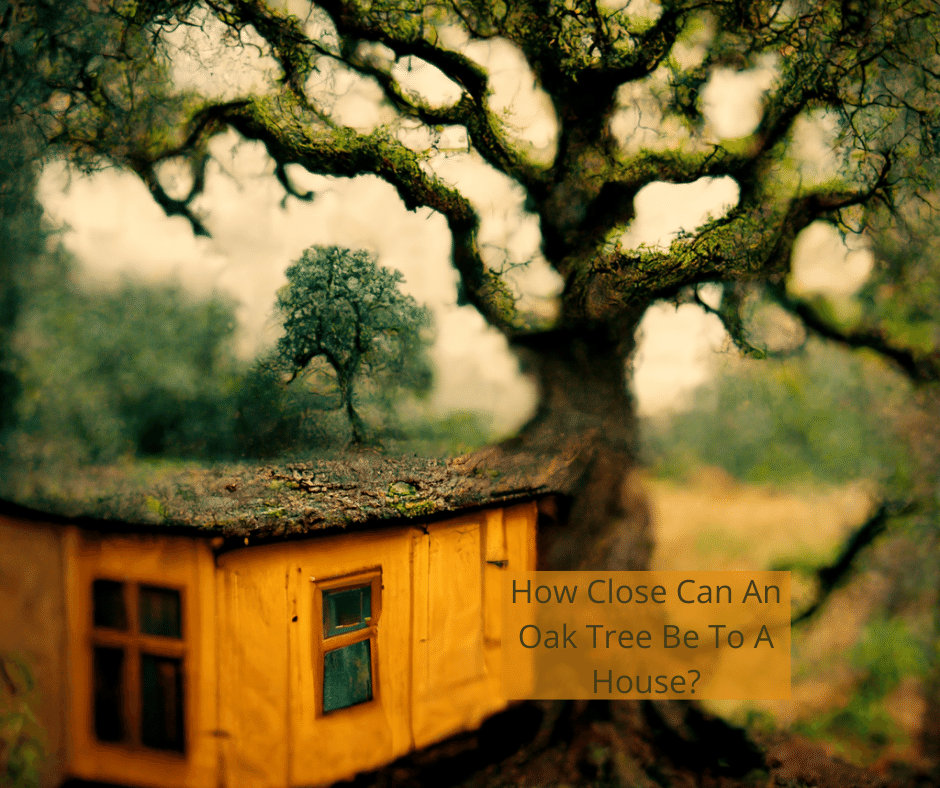
Planting an oak tree close to your house involves important decisions. The type of tree you choose plays a significant role. Some trees may do well near your home, while others may not be the best choice. When selecting an oak tree to plant near your residence, go for one with roots that don’t spread out too much. These trees are perfect for anyone wanting a big, impressive tree. If you’re aiming for a stunning addition to your yard, this is the perfect option for you.
Roots Grow Between One and Three Times the Width of The Canopy of The Tree
As a result, the roots of an oak tree can extend more than 20 feet. This is much greater than the average diameter of a tree’s trunk, but this does not mean that the tree is dangerous. Its roots are comprised of numerous smaller, fibrous root hairs. This is an essential factor to consider when planting an oak tree. Moreover, it is necessary to plant it at a distance of at least 25 feet from structures and other trees.
The roots of oak trees are very diverse. Red oak, for example, has a root system similar to the Texas red oak. For the best root development, ensure the soil is well-drained and has slight acidity. Also, it should receive a high proportion of sunlight. To prevent root disease, you can amend the soil with compost or manure and provide adequate moisture. After adding compost, be sure to backfill the hole with soil that is perpendicular to the ground. If you don’t backfill the hole properly, your oak may grow at an angle, so be careful.
The roots of oak trees can reach a depth of 18 inches. To support their large hearts, they need ample space to grow in. As a result, they grow in between one and three times the width of the tree’s canopy. Oak trees need an unobstructed space underneath the ground to properly absorb water and nutrients. The roots of oak trees can share their root system through grafting.
Non-Invasive Root Systems Are Best for Planting Near a House
If you plan to plant an oak tree near a house, you need to consider two factors: the size of the tree and its root system. You don’t want your new tree to grow too large or spread out its roots, so you must choose a non-invasive tree with a small root system. In addition, you want to avoid planting a tree that will grow into a large tree and create a problem for your septic system or sewer system.
To avoid this problem, choose trees with non-invasive root systems. These roots go deep into the ground without causing damage to the house or septic system. If you don’t want to worry about your roots causing problems, choose a non-invasive tree. You can plant it near a house or patio if it has a non-invasive root system.
Another non-invasive tree you can plant near a house has a shallow root system. These include the American hornbeam tree, the Adams crabapple tree, and the dwarf plum. These trees don’t cause problems for surrounding plants and can be planted near a house without causing any harm. When choosing a non-invasive tree, ask the landscape gardener for advice.
While trees can provide shade and windbreaks, they can also damage a house. The biggest problem stems from trees with large roots. Invasive trees, such as oaks, poplars, and ash trees, can cause major damage to your foundation. As a result, you should choose smaller trees that have shallow roots and do not pose much threat to your foundation.
Oak Trees Are Hard to Rake
You may wonder, “How close can an oak tree be to a home?” An oak tree’s roots can extend up to seventy-five feet (20 meters) from the main trunk. While they are large and thick near the top of the tree, they taper off dramatically as they get closer to the ground. You’ll want to plant your oak tree at least 20 feet from your home. The reason for this is that the oak tree’s roots could reach your septic tank or water lines.
The distance between your oak tree and home is critical for its health and beauty. Depending on the size of the oak tree, you may want to plant it as far away as 20 feet. However, if you decide to plant a larger oak tree, you’ll need to leave it farther away. Make sure to plant your oak tree in a location with full sun so that its roots can grow properly. Also, remember that your oak tree will grow a lot over time, and you’ll need to account for its size.
While you can plant an oak tree anywhere, it’s best to choose a location far from home to ensure it doesn’t cause problems for your home. In general, you should place large trees at least 20 feet from a house. You also want to plant oak trees far enough apart to create an optimum forest stand. You’ll also need to leave enough space between oak trees for seedlings to grow and share nutrients.
They Drain Water Beneath the Foundation
The roots of an oak tree can cause a house to sink under the weight of water, causing a problem called subsidence. The subsidence process is due to a moisture loss in the soil beneath the house. Often people compare this condition to settling. Oak trees have long roots extending well beyond the branches, reaching 1.5 to 2.5 times the tree’s height. A large oak tree can take up to 40,000 gallons of water per year, resulting in a shaky foundation.
When planting oak trees, space them at least 15 feet apart. The roots of an oak tree are long and strong and can penetrate the foundation of a home. You can’t plant the trees too close together, though, as their branches grow together. Even though oak trees are a common home tree in the South, they can still be detrimental to the foundation of your house.
A tree’s roots are 1.5 to 2.5 times the tree’s height, meaning a 50-foot oak will have roots up to 75 feet or more. Even the tiniest tree can cause a house to sink or settle. The soil beneath an oak tree is expansive, meaning it can eat away at the home’s foundation. Because of this, the soil beneath an oak tree can be incredibly dry.
To prevent a house from sinking under an oak tree’s roots, you should carefully dig around the foundation. If you have to dig up the ground, make sure to place the irrigation drip line several inches below the soil surface. In the case of a mature oak tree, watering should be avoided near the base. A drip line can help prevent the roots from soaking up the water in the ground.
They Attract Insects
If you have an oak tree in your yard, you might have noticed that it is attracting a lot of insects, from beetles to worms. The worms love the oak’s leaves and can cause the leaves to fall off. Meanwhile, the beetles love the oak’s bark and can introduce disease. However, this is not a problem for most people since oaks require little maintenance.
The adult female oak lecanium is approximately one-sixteenth to a quarter inch in diameter. Male oak lecaniums are brown or reddish. These insects lay their eggs on oak leaves in April and May, and the larvae feed on the sap from the leaves. Severe infestations of oak lecaniums can stunt plant growth and cause honeydew and sooty mold on the leaves.
The sap-feeders can also cause damage to your tree. Aside from discoloration and dropping of leaves, these insects also distort new growth. In addition, their honeydew can attract colonies of sooty mold, which doesn’t feed on the plants, but inhibits photosynthesis. They also rain down sticky honeydew on anything they land on. If you have a small oak, you can try spraying it with insecticidal soap or horticultural oils. However, larger oaks will be best left alone as they can keep their population down naturally.
As oaks are a great food source, they also offer an excellent habitat for insects. They can be planted in your backyard or forest. However, you should not plant them too close to the house as they can clog your home’s foundation. You should also avoid planting oaks too close to power lines. This is because power lines can potentially damage them. If you want to plant them, however, be sure to check the soil before planting them in the yard.
I’m Theodore, and I love tiny houses. In fact, I’m the author of Tiny House 43, a book about tiny houses that are also tree houses. I think they’re magical places where imaginations can run wild and adventures are just waiting to happen.
While tree houses are often associated with childhood, they can be the perfect adult retreat. They offer a cozy space to relax and unwind, surrounded by nature. And since they’re typically built on stilts or raised platforms, they offer stunning views that traditional homes simply can’t match.
If you’re looking for a unique and romantic getaway, a tree house tiny house might just be the perfect option.
Home and Garden
How Cheap Can I Build a Tiny House
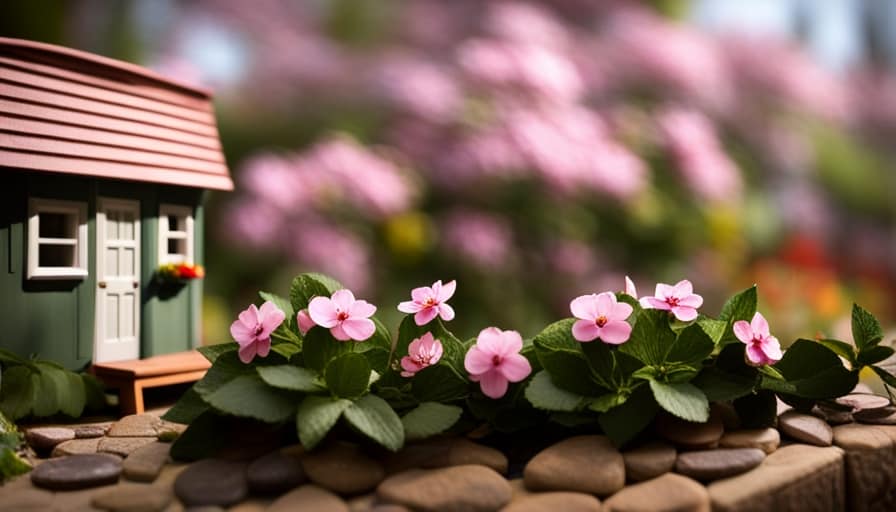
Hey there! Have you ever thought about how cost-effective it can be to construct a tiny house? You’re not alone. Did you know that the average cost of a traditional home in the US is approximately $280,000?
But fear not! I’m here to show you that building a tiny house can be a budget-friendly alternative. From finding affordable materials to cost-saving design tips, I’ll guide you through the process of creating your very own affordable and cozy tiny home.
Let’s get started!
Key Takeaways
- Make a thorough list of necessary materials and estimate their costs to create a realistic budget and stick to it throughout the building process.
- Look for affordable building materials by exploring deals and discounts at local hardware stores, salvage options, and online marketplaces.
- Utilize cost-saving design and space optimization techniques such as multifunctional furniture, built-in storage solutions, and maximizing vertical space.
- Consider the pros and cons of DIY-ing your tiny house versus hiring professionals, taking into account your skills, resources, and time commitment.
Planning and Budgeting for Your Tiny House
I can start planning and budgeting for my tiny house by making a list of necessary materials and estimating their costs.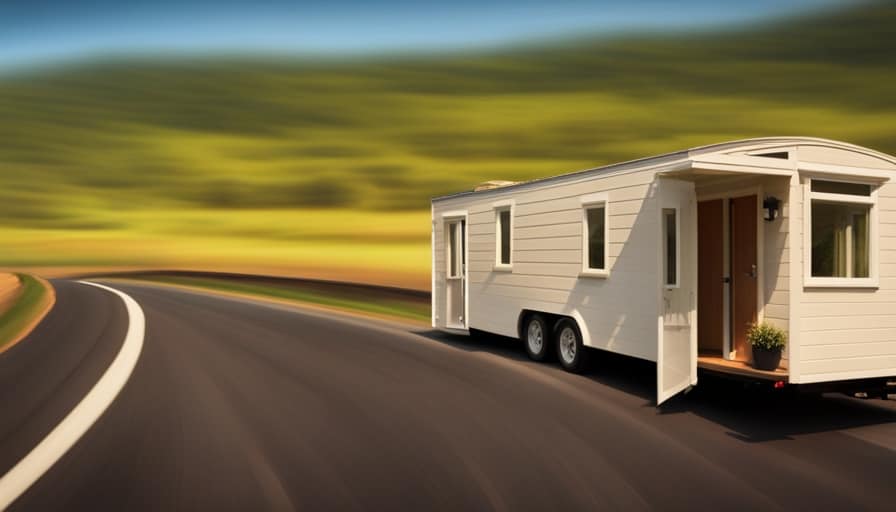
When it comes to financing options for my tiny house, there are a few routes I can explore.
One option is to secure a personal loan from a bank or credit union. This can provide the necessary funds upfront, allowing me to build my tiny house without delay.
Another option is to consider crowdfunding platforms, where I can reach out to a community of people who are willing to support my project financially.
Additionally, I can explore the possibility of using my savings or seeking assistance from family and friends.
In terms of cost-effective storage solutions, I can utilize clever space-saving techniques such as built-in shelving, hidden drawers, and multi-functional furniture.
This will help maximize the use of every inch of my tiny house and make the most out of the available space.
Finding Affordable Building Materials
When searching for affordable building materials, I can start by looking for deals and discounts at local hardware stores or online marketplaces. It’s also worth considering alternative materials and affordable salvage options. These can often be found at salvage yards, demolition sites, or even through online classifieds. By being resourceful and thinking outside the box, I can find materials that are not only affordable but also environmentally friendly. Here is a table that highlights some alternative materials and their benefits:
| Material | Benefits |
|---|---|
| Recycled lumber | Cost-effective, reduces environmental impact |
| Shipping containers | Durable, readily available, customizable |
| Reclaimed bricks | Adds character, reduces waste |
Cost-Saving Design and Space Optimization
How can I save costs and optimize space in my tiny house design?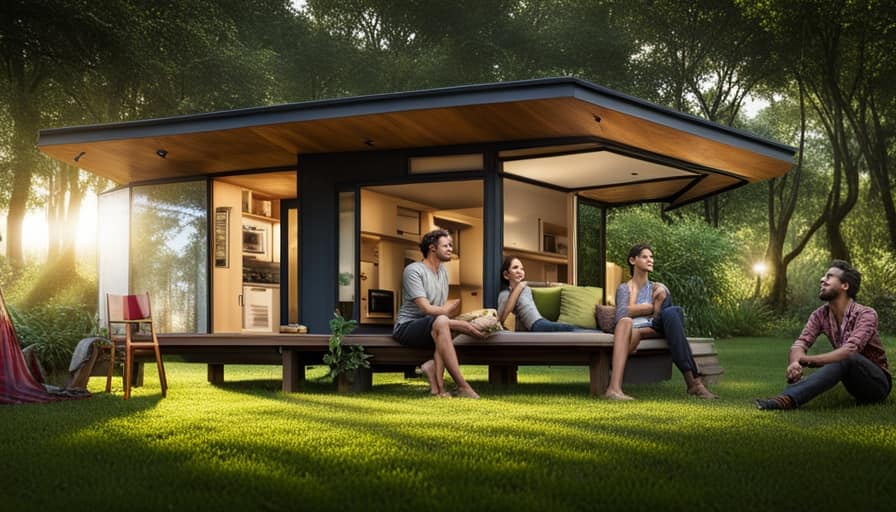
Here are some cost-effective construction methods and creative storage solutions to consider:
-
Utilize multifunctional furniture: Look for pieces that can serve multiple purposes, such as a sofa that can convert into a bed or a dining table that can double as a workspace.
-
Maximize vertical space: Install shelves, cabinets, and hooks on walls to make use of every inch of available space.
-
Incorporate built-in storage: Design custom-built cabinets and drawers that fit seamlessly into the layout of your tiny house.

-
Use natural light: Opt for large windows and skylights to maximize natural light and create a sense of openness.
DIY Vs. Hiring Professionals: Which Is Cheaper
To determine the most cost-effective option, it’s important to weigh the pros and cons of DIY-ing your tiny house versus hiring professionals.
When it comes to building a tiny house, there are several factors to consider. Building it yourself can save you money on labor costs, as well as give you a sense of accomplishment and pride in your creation. However, it also requires a certain level of skill, knowledge, and time commitment.
Hiring professionals, on the other hand, ensures that you have experienced individuals who can handle the construction process efficiently and effectively. They can also provide guidance and expertise when it comes to navigating building codes and regulations. However, this convenience comes at a higher cost.
Ultimately, it depends on your personal skills, resources, and priorities. If you have the necessary skills and time, DIY-ing your tiny house can be a rewarding and cost-effective option. However, if you lack the skills or prefer a hassle-free experience, hiring professionals may be worth the investment.
Tips for Saving Money on Off-Grid Systems and Utilities
I’ve discovered some clever ways to save money on off-grid systems and utilities. Here are some tips to help you save on your solar power and minimize water usage:
-
Invest in energy-efficient appliances: Look for appliances with the Energy Star label to ensure they consume less electricity, saving you money in the long run.
-
Optimize your solar power system: Properly size your solar power system to meet your energy needs without overspending on unnecessary equipment.
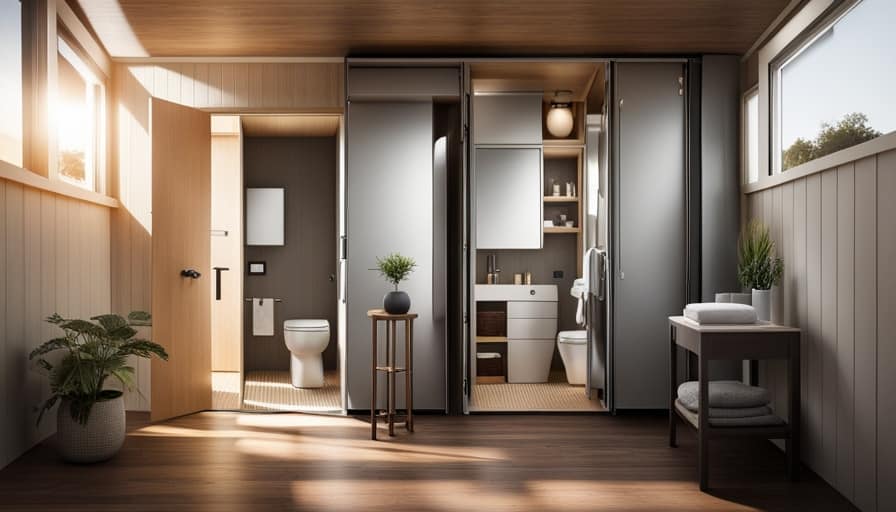
-
Implement water-saving measures: Install low-flow faucets, showerheads, and toilets to reduce water consumption. Collect rainwater for irrigation or flushing toilets to further minimize usage.
-
Practice energy conservation: Turn off lights and unplug appliances when not in use. Use natural light and ventilation whenever possible to reduce reliance on electricity and save money.
Frequently Asked Questions
Can I Build a Tiny House Without a Building Permit?
Yes, you can build a tiny house without a building permit in some cases. However, it’s important to be aware of building permit exemptions and legal considerations to ensure you stay within the law.
What Are Some Common Hidden Costs Associated With Building a Tiny House?
Hidden costs associated with building a tiny house can catch you off guard. It’s crucial to plan your budget carefully, considering expenses like permits, utilities, and specialized tools. Budget planning is essential to avoid surprises.
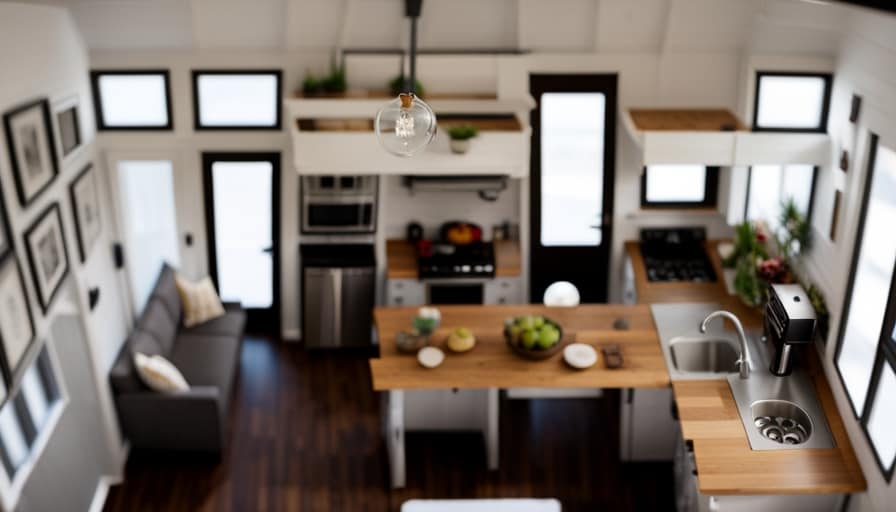
Are There Any Grants or Funding Options Available for Building a Tiny House?
Grants and crowdfunding opportunities can be great options for funding a tiny house project. Many organizations offer grants for sustainable housing initiatives, and crowdfunding platforms allow you to raise money from supporters.
How Much Does It Cost to Transport a Tiny House to a New Location?
Transporting a tiny house to a new location can vary in cost depending on the distance and method of transportation. It’s important to consider relocation expenses when planning your budget for building a tiny house.
Can I Build a Tiny House on Wheels to Avoid the Costs of Purchasing Land?
Building a tiny house on wheels has advantages like mobility and cost savings. However, it’s important to consider the legal aspects of parking and living in one. Research local regulations and consult professionals for guidance.
Conclusion
In conclusion, building a tiny house on a budget requires careful planning, resourcefulness, and cost-saving strategies.
By finding affordable building materials, optimizing space, and considering DIY options, you can significantly reduce expenses.
Additionally, saving money on off-grid systems and utilities can contribute to long-term affordability.
Remember, building a tiny house is like creating a masterpiece on a small canvas, where every brushstroke counts towards achieving your dream home within your means.
I’m Theodore, and I love tiny houses. In fact, I’m the author of Tiny House 43, a book about tiny houses that are also tree houses. I think they’re magical places where imaginations can run wild and adventures are just waiting to happen.
While tree houses are often associated with childhood, they can be the perfect adult retreat. They offer a cozy space to relax and unwind, surrounded by nature. And since they’re typically built on stilts or raised platforms, they offer stunning views that traditional homes simply can’t match.
If you’re looking for a unique and romantic getaway, a tree house tiny house might just be the perfect option.
Tree Planting and Maintenance
How Do I Get Financial for Tiny House and Land
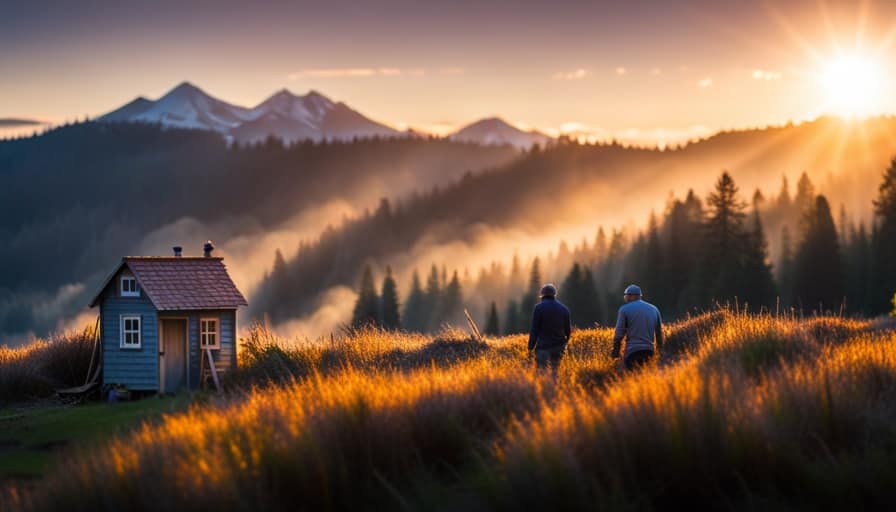
I’m here to assist you in navigating the thrilling adventure of obtaining financial assistance for your dream of owning a tiny home and property.
From exploring traditional financing options to tapping into government assistance programs, I’ll guide you through the process step by step.
With crowdfunding, community support, and self-financing strategies at your disposal, you’ll discover a world of possibilities.
Let’s dive into this article to uncover alternative financing options and make your dream a reality.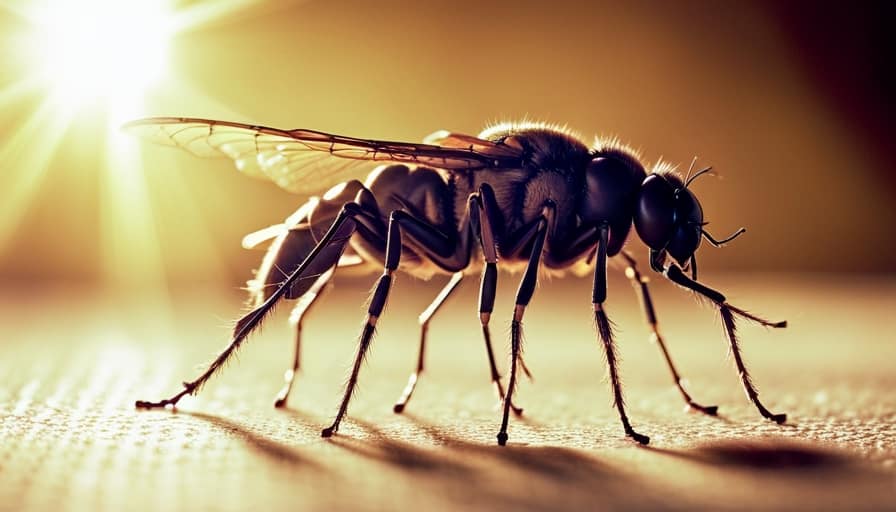
Key Takeaways
- Traditional financing options such as personal loans or mortgage loans from banks or online lenders can secure funds for a tiny house and land project.
- Government assistance programs, including grants, subsidies, and low-income housing programs, can provide financial support for acquiring land, construction, or renovations.
- Crowdfunding and community support can be effective in raising funds for a tiny house and land project by sharing the project on crowdfunding platforms and engaging with the community.
- Self-financing strategies like seller financing, personal savings, and cutting expenses can be explored to accumulate enough funds for acquiring a tiny house and land.
Exploring Traditional Financing Options
I can start exploring traditional financing options to get financial support for my tiny house and land. There are several avenues I can explore, such as personal loan options and mortgage possibilities.
Personal loans can be obtained from banks, credit unions, or online lenders. These loans provide flexibility in terms of repayment and can be used for various purposes, including funding a tiny house project.
On the other hand, mortgage options can be explored if I’m looking to purchase land along with my tiny house. This involves applying for a mortgage loan from a financial institution that specializes in financing land and property.
By considering these traditional financing options, I can secure the necessary funds for my tiny house and land project.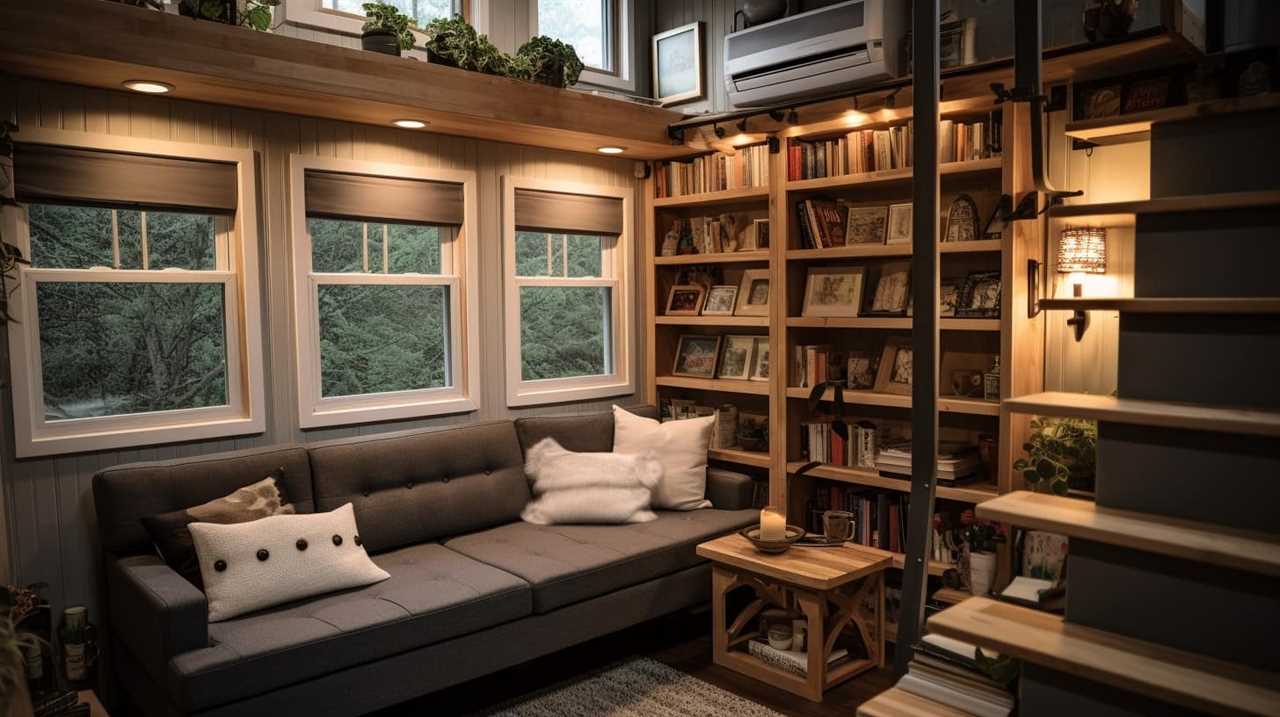
However, if I need further assistance, I can also tap into government assistance programs that cater specifically to housing projects like mine.
Tapping Into Government Assistance Programs
To tap into government assistance programs, I can explore options such as grants, subsidies, and tax incentives that are available for funding my tiny house and land project. Government grants can provide financial support specifically designed for low-income individuals or families who are looking to build or purchase affordable housing. These grants can help cover the costs associated with land acquisition, construction, or renovations. Additionally, there are various low-income housing programs that offer subsidies to help reduce the monthly costs of homeownership, making it more affordable for individuals with limited financial resources.
Taking advantage of these government assistance programs can significantly alleviate the financial burden of funding a tiny house and land project.
Transitioning into the next section, crowdfunding and community support can also be effective strategies to raise funds for this endeavor.
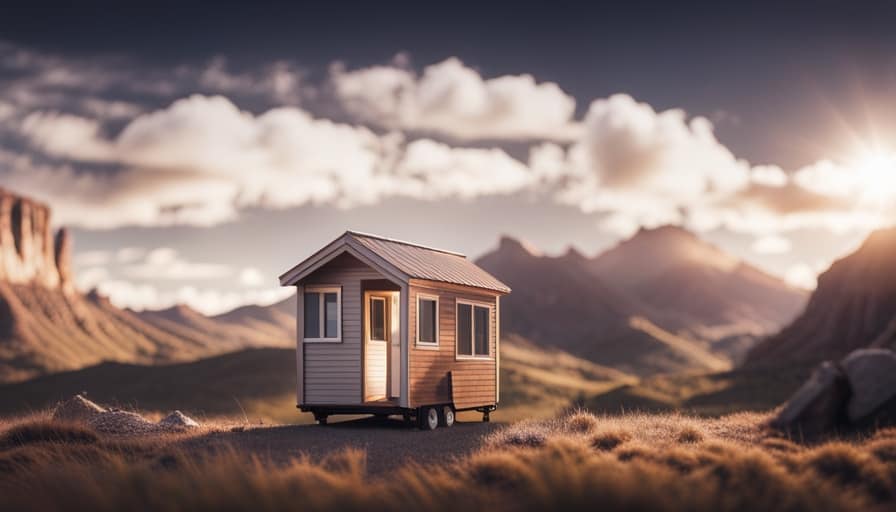
Crowdfunding and Community Support
One effective way to raise funds for my tiny house and land project is through crowdfunding and community support. This approach allows me to reach out to a wider audience and tap into the collective power of a supportive community.
Here are three reasons why community fundraising and crowdfunding can be a great option for financing my project:
-
Increased visibility: By sharing my project on crowdfunding platforms and engaging with my community, I can attract attention and support from a larger audience.
-
Shared ownership: When people contribute to my project, they become invested in its success. This shared ownership can create a strong sense of community support.
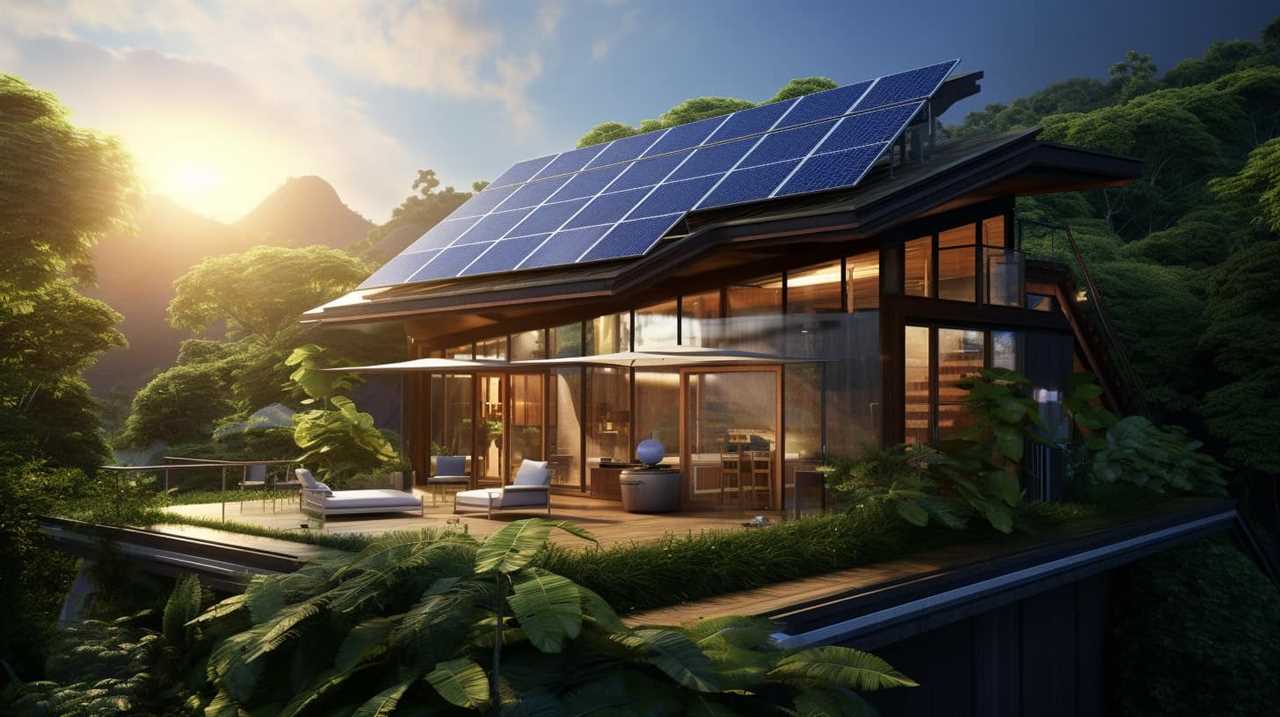
-
Loan options: Some crowdfunding platforms also offer loan options, allowing me to secure the funds I need while providing backers with the opportunity to earn a return on their investment.
Self-Financing Strategies for Tiny House and Land
A potential strategy for financing my tiny house and land project is to explore self-financing options.
One option is seller financing, where the seller acts as the lender and allows the buyer to make monthly payments directly to them. This can be a mutually beneficial arrangement as it eliminates the need for a traditional mortgage and allows for more flexibility in negotiating terms.
Another option is to use personal savings to fund the project. By saving diligently and cutting expenses where possible, it’s possible to accumulate enough funds to cover the costs of both the tiny house and the land. However, it’s important to consider the time and effort required to save enough money and to ensure that it aligns with your long-term financial goals.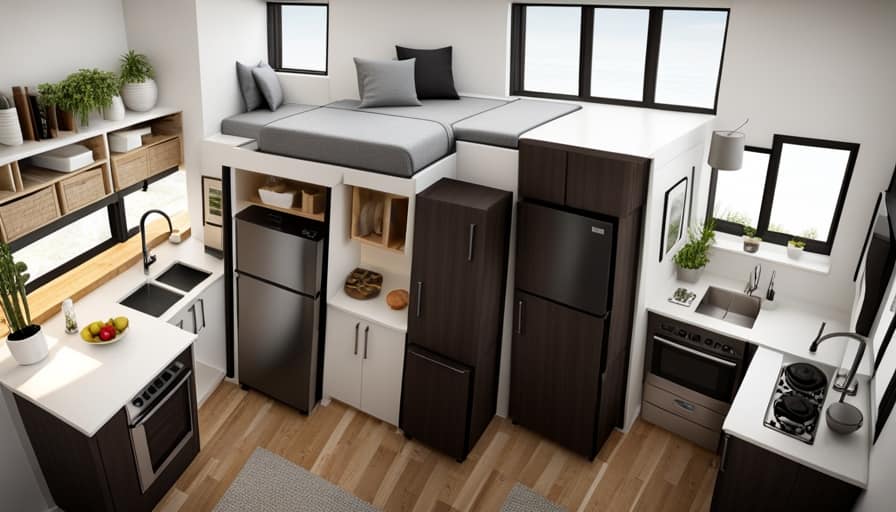
Exploring alternative financing options can provide additional avenues to secure funding for your tiny house and land project.
Exploring Alternative Financing Options
I can consider applying for a loan from a credit union or community bank to explore alternative financing options for my tiny house and land project. While traditional lenders may not be familiar with financing tiny homes, there are other options available that cater specifically to alternative housing projects.
Here are some alternative financing options to consider:
-
Microloans for tiny house and land: Microloans are small loans typically offered by non-profit organizations or community development financial institutions. These loans are specifically designed to help individuals finance small-scale projects, such as building a tiny house. They often come with more flexible terms and lower interest rates than traditional loans.
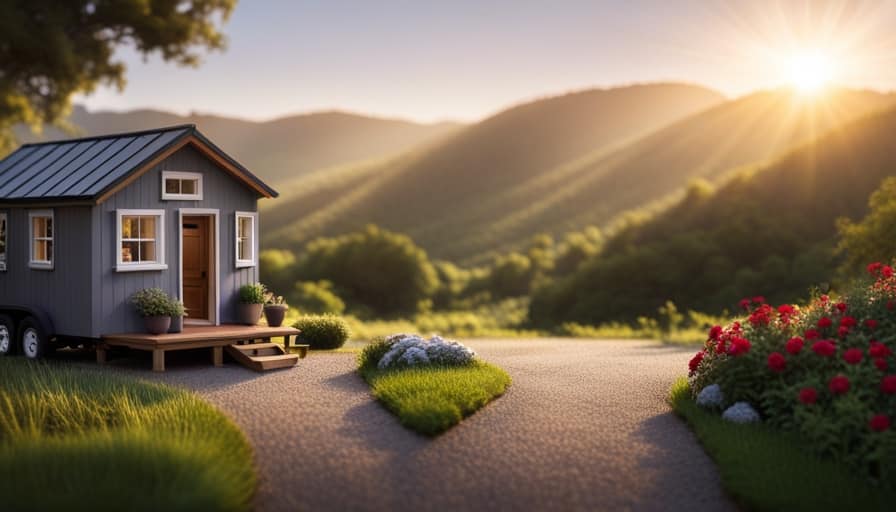
-
Peer to peer lending for alternative housing finance: Peer to peer lending platforms connect borrowers directly with individual lenders, bypassing traditional financial institutions. These platforms provide an alternative way to access funding for your tiny house and land project, with potentially lower interest rates and more flexible repayment options.
-
Crowd funding: Crowd funding platforms allow you to raise funds from a large number of people who are interested in supporting your tiny house and land project. By creating a compelling campaign and showcasing your vision, you can attract individuals who are passionate about alternative housing and willing to contribute financially.
Exploring these alternative financing options can help you find the funding you need to make your tiny house and land project a reality.
Frequently Asked Questions
Can I Use My Existing Mortgage to Finance a Tiny House and Land?
Using my existing mortgage for a tiny house and land has pros and cons. It can provide convenience but might require refinancing. Alternatively, explore financing options like personal loans, RV loans, or crowdfunding to purchase a tiny house and land.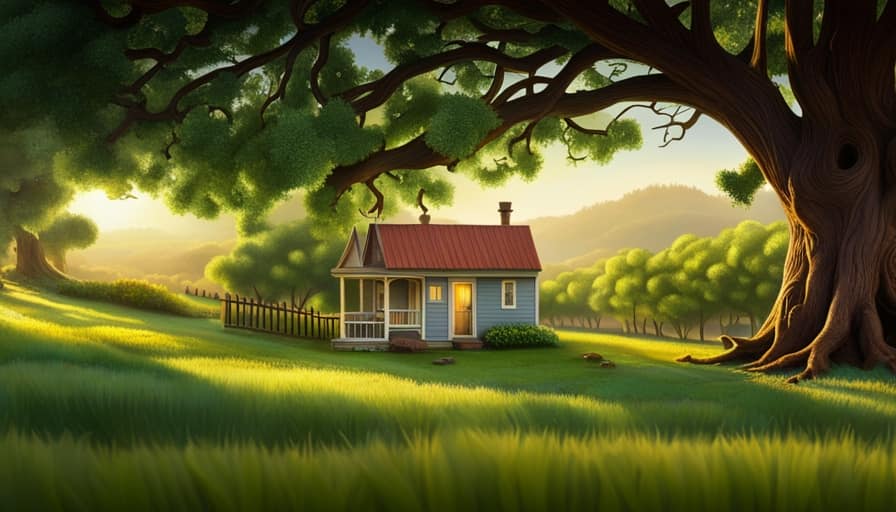
Are There Any Grants Available Specifically for Financing a Tiny House and Land?
There are alternative financing options for purchasing a tiny house and land, such as exploring crowdfunding opportunities. Grants specifically for financing a tiny house and land may also be available.
Can I Use a Personal Loan to Finance the Purchase of a Tiny House and Land?
Yes, you can use a personal loan to finance the purchase of a tiny house and land. However, it’s important to consider other options like using personal savings or crowdfunding for a more sustainable and affordable approach.
Are There Any Tax Benefits or Incentives for Financing a Tiny House and Land?
There are potential tax benefits and incentives available for financing a tiny house and land. These can help reduce the overall cost and make it more affordable in the long run.
Can I Use a Home Equity Line of Credit (Heloc) to Finance a Tiny House and Land?
Yes, a home equity line of credit (HELOC) can be used to finance a tiny house and land. However, it’s important to consider the pros and cons, such as interest rates and potential risks, before making a decision.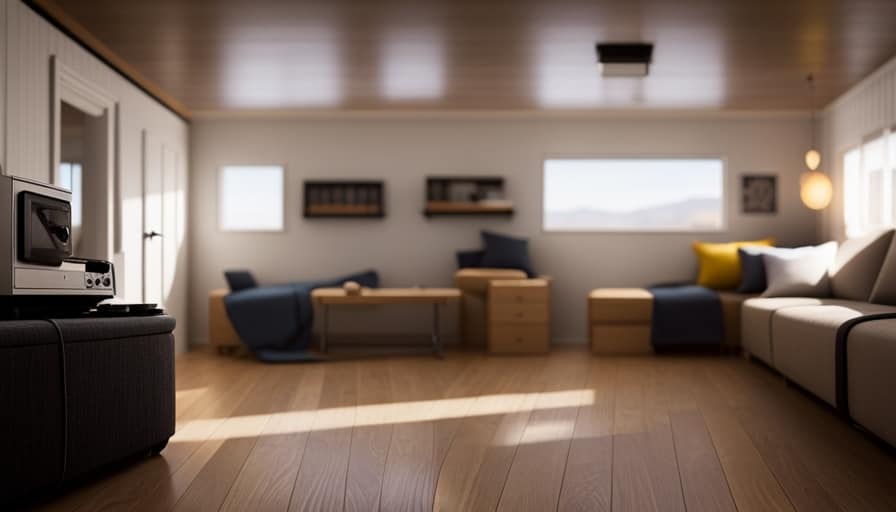
Conclusion
In conclusion, the journey of obtaining financial support for a tiny house and land can be challenging but not impossible. By exploring traditional financing options, government assistance programs, crowdfunding, and self-financing strategies, individuals can find solutions that work for their unique circumstances.
Additionally, considering alternative financing options can open up new possibilities. Remember, with determination and resourcefulness, the dream of owning a tiny house and land can become a reality, bringing a sense of freedom, simplicity, and fulfillment.
I’m Theodore, and I love tiny houses. In fact, I’m the author of Tiny House 43, a book about tiny houses that are also tree houses. I think they’re magical places where imaginations can run wild and adventures are just waiting to happen.
While tree houses are often associated with childhood, they can be the perfect adult retreat. They offer a cozy space to relax and unwind, surrounded by nature. And since they’re typically built on stilts or raised platforms, they offer stunning views that traditional homes simply can’t match.
If you’re looking for a unique and romantic getaway, a tree house tiny house might just be the perfect option.
-

 Beginners Guides3 months ago
Beginners Guides3 months agoHow To Buy A Tesla Tiny House
-

 Energy Efficiency3 weeks ago
Energy Efficiency3 weeks agoBest Tiny Homes For Cold Climates
-

 Beginners Guides3 months ago
Beginners Guides3 months agoTiny House Nation Where Are They Now Stephanie
-

 Tiny House Resources (e.g., legalities, cost, insurance, FAQs)1 month ago
Tiny House Resources (e.g., legalities, cost, insurance, FAQs)1 month agoDo Tiny Homes Need Planning Permission?
-

 Beginners Guides3 months ago
Beginners Guides3 months agoFrom The Show Tiny House Nation How Many Keep Their Tiny House?
-

 Beginners Guides1 month ago
Beginners Guides1 month agoUsing a Climbing Net For Treehouse Construction
-

 Beginners Guides1 month ago
Beginners Guides1 month agoHow to Build a Treehouse Without Drilling Into the Tree
-

 Beginners Guides1 month ago
Beginners Guides1 month agoHow to Build a Treehouse Rope Bridge






